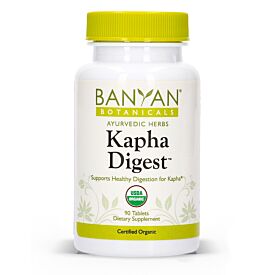The Digestive Process: An Ayurvedic Perspective
One of Ayurveda’s teachings is that we are not what we eat, but rather what we digest. This play on the well-known saying, “You are what you eat” is meant to illustrate that digestion is of utmost importance in staying healthy. However, how much do we truly understand about the digestive process? Ayurveda provides us with an in-depth view that goes beyond what is commonly known. A few key features of the Ayurvedic take on digestion include the idea that the whole process happens in three stages, that digestion happens on a subtle level as well as a gross physical one, and that it takes a full 36 days to complete the digestive process. Here is a break-down with more information.
Three Stage Process
The typical duration of digestion through the GI tract is about 4–6 hours, depending on the agni (digestive fire) and constitution of the individual. This process is broken down into three stages:
- Stage One—Mouth and upper stomach. This stage takes about 1 ½–2 hours and is associated with kapha, or the Earth and Water elements. At this stage, saliva mixes with food to make it moist, foamy, and oily so the food can be well digested. Lethargy for more than an hour after ingesting food indicates that this stage of digestion is compromised and food is staying here too long.
- Stage Two—Lower stomach and small intestine. This stage takes about 2–3 hours and is associated with pitta, or the Fire and Water elements. This is when pancreatic secretions further break down the food. Heartburn and acid reflux are related to imbalances in this stage.
- Stage Three—Large intestine (colon). This stage takes about 1 ½–2 hours and is related to vata, which is the Air and Space elements. Bloating and gas indicate a problem with this stage of digestion.

Gross vs. Subtle Digestion
Most people are aware of the “gross” digestive process in which food travels through the GI tract, separating nutrients from waste. However, we are generally unaware that once this process is finished, the body continues on with the “subtle” digestive process. Subtle digestion is the process of nourishing each tissue layer of the body in turn.
Once food has completed the gross digestive process, waste is escorted to the GI tract for removal from the body, and what is left is called ahara rasa, or nutrient fluid. This nutrient fluid is then carried to each of the tissue layers, which are nourished in the following order:
- Lymph/plasma (rasa)
- Blood (rakta)
- Muscle (mamsa)
- Fat (meda)
- Bone (asthi)
- Bone marrow/nerve tissue (majja)
- Reproductive (shukra/artava)
One way to describe how subtle digestion nourishes these tissue layers is through the analogy of irrigation; an irrigation channel full of water nourishes each row of crops, with the nearest portion receiving water first and the portion at the end receiving water last. In this same way, the nutrient fluid is carried from one tissue to the next in its proper order.
However, sometimes a tissue layer is depleted and needs more nutrients. In this case, the normal process is bypassed and the tissue layer with the greatest need will be nourished first.
You Are What You Digested…36 Days Ago
According to Ayurveda, the entire process of digestion takes about 36 days, ending with the creation of ojas—the most refined by-product of digestion. Ojas is the prime energy reserve of the body and the seat of our immune system. It protects life, gives us strength, controls our heartbeats, and maintains the balance of all of our tissues.
The process of our food's nourishment goes through each of our seven tissue layers in turn, providing the nutrients each layer needs as follows (number of days after ingestion):
Days 1–5: formation of blood plasma, serum, and lymphatic fluid
Days 6–10: formation of new red blood cells
Days 11–15: formation of muscle tissue
Days 16–20: formation of fat tissue
Days 21–25: formation of bones
Days 26–30: formation of bone marrow and nerve tissue
Days 31–35: formation of sperm and ovum
Day 36: formation of ojas
The body is an incredible vessel, with seemingly perfect systems in place to keep us healthy and vibrant. Ayurveda teaches us that the digestive process is complex, and undoubtedly crucial to our health and well-being. So, tend to your fire. Learn how it works and why. And discover what you can do to keep your agni burning bright and strong.












